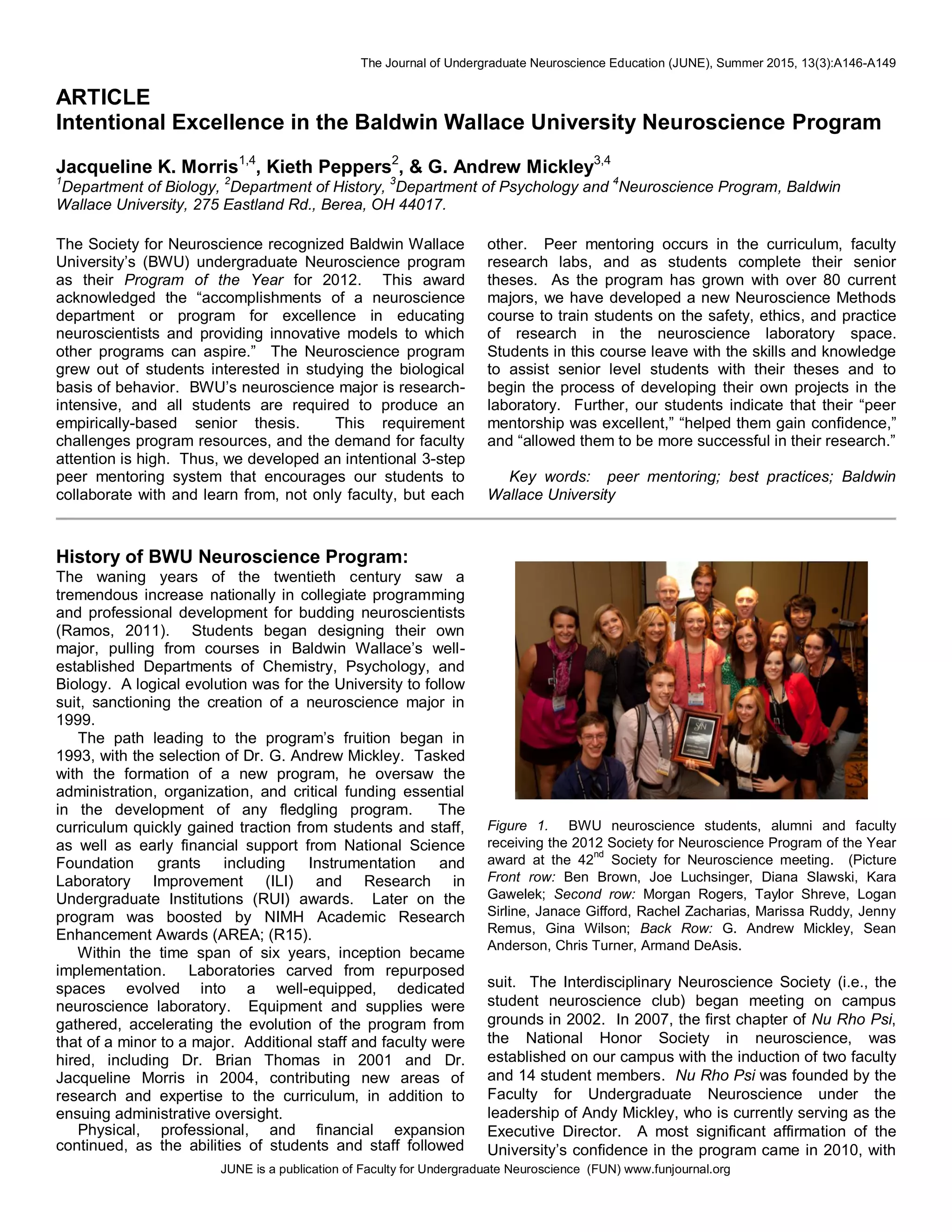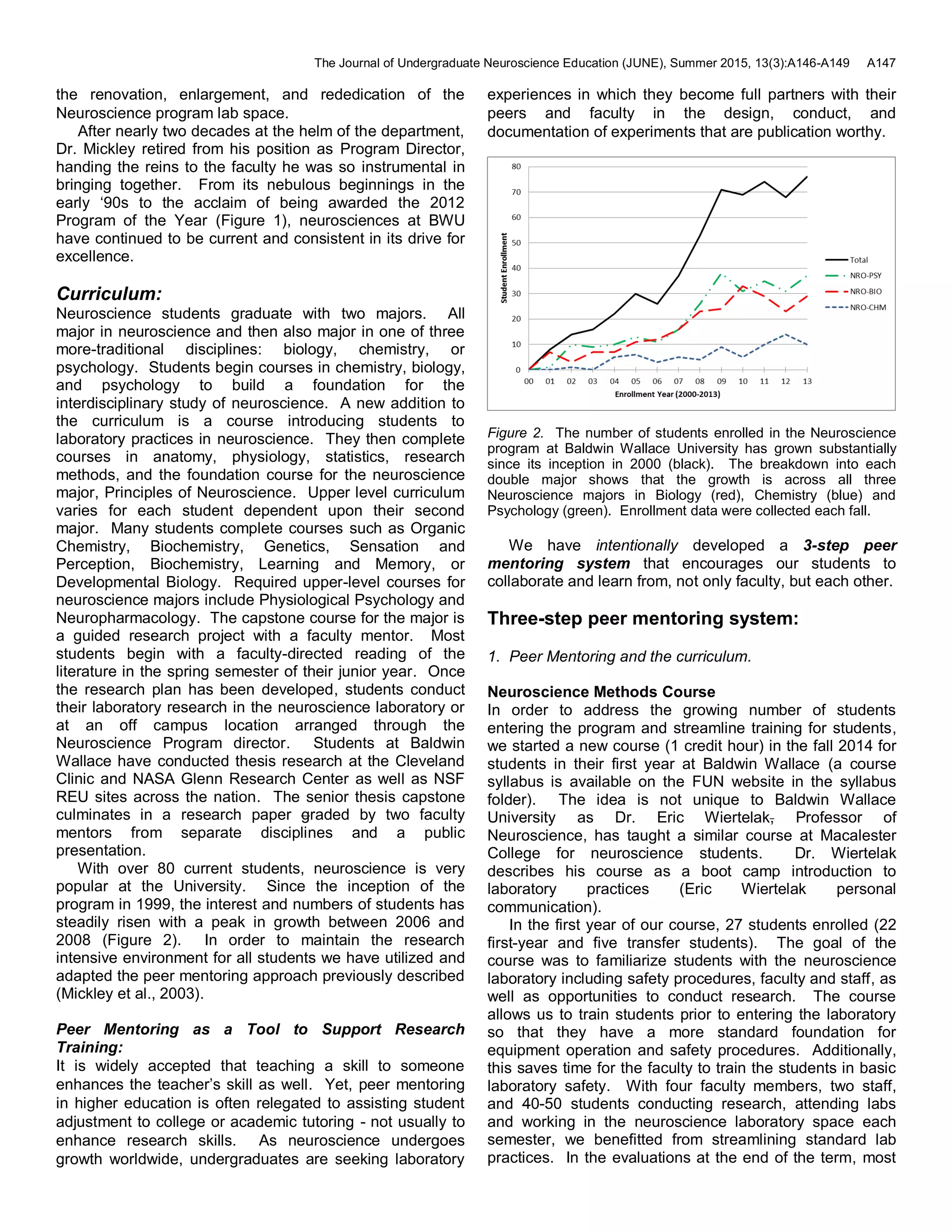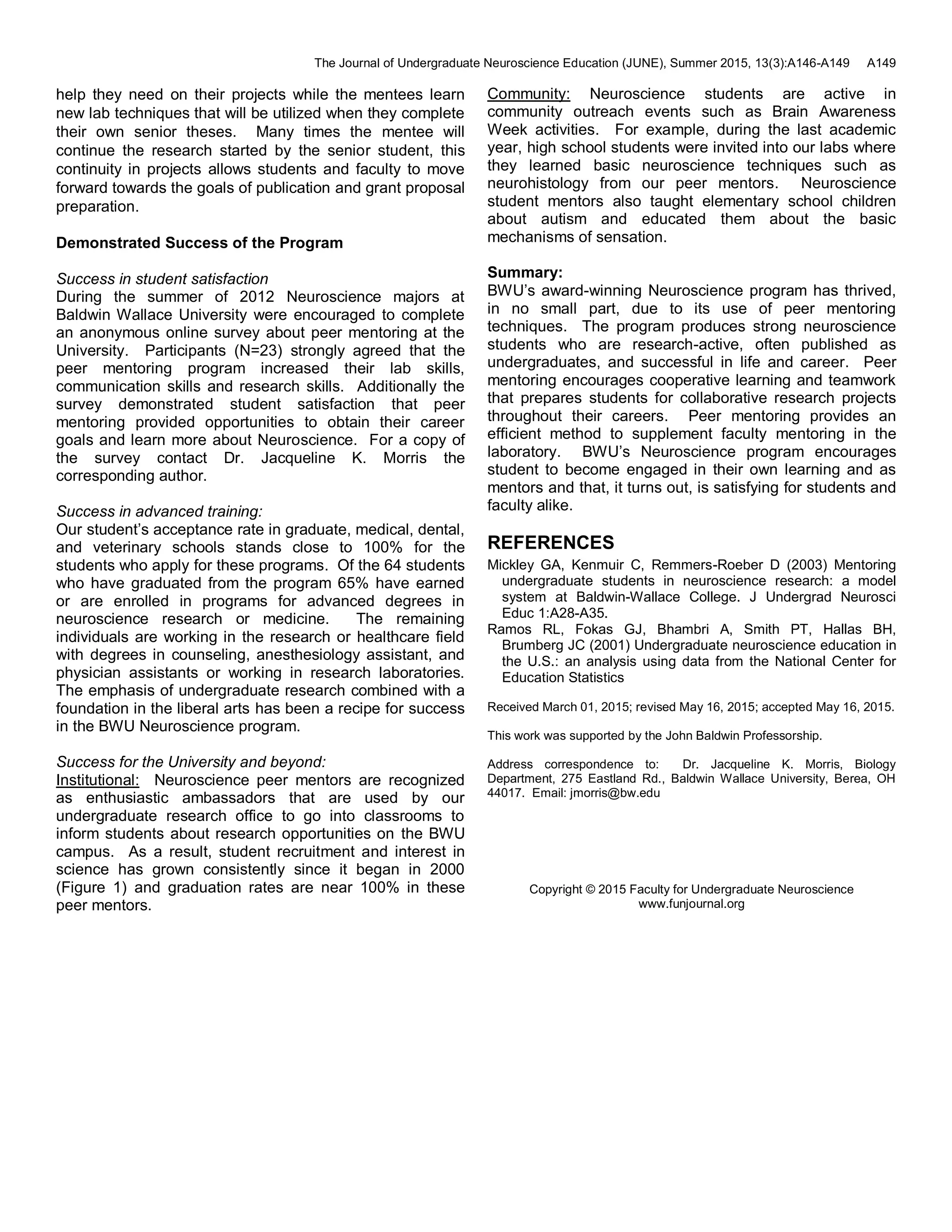The Baldwin Wallace University Neuroscience program was recognized as Program of the Year in 2012 by the Society for Neuroscience. The program has grown substantially since its inception in 1999 and now has over 80 neuroscience majors. A key part of the program's success is its intentional 3-step peer mentoring system. First, peer mentoring occurs through a new Neuroscience Methods course and supplemental instruction. Second, students work in faculty research labs and are trained using a progressive system. Third, senior students mentor underclassmen as they complete their required senior thesis projects. This peer mentoring approach has led to high student satisfaction and advanced training outcomes.


![Morris et al. Intentional Excellence in Neuroscience Program A148
students felt that the laboratory safety, animal handling and
equipment tutorials were important skills learned during the
course. Another outcome from the course was that six
students decided not to pursue a neuroscience major.
Many students enter a neuroscience major without a
complete understanding of the reality of conducting
research and laboratory practices. During this course,
students were immersed in the neuroscience lab and
techniques which allowed them to make an informed
decision about their future early in their college experience.
Another goal in this course was to explore career
opportunities in neuroscience using the Society for
Neuroscience website. Students watched the videos of
neuroscientists in a variety of careers and then reflected on
their own future career in neuroscience. Many students
see neuroscience as a pathway to medicine or research,
but not teaching, policy advocacy, science writing or work
in the pharmaceutical industry - to name a few.
Neuroscience students were excited to learn about the
variety of careers open to them and enjoyed taking the
time to analyze how their strengths and weaknesses would
match a variety of career paths.
“It [Neuroscience Methods course] has exposed me to
peers with similar interest as well as given me a peek at
what actually happens in the lab. It’s one thing to see
data; it’s another to know where the data come from and
how to obtain it.” Anonymous first year Neuroscience
major on course evaluation in Fall 2014
Additionally, this course encouraged students to
strengthen their math skills. We used lab math worksheets
(available online http://www.bio-link.org/GMP/math.htm) to
test their skills in calculating proportions, molarity, and
dilutions. Students with diffi-culties in lab math had time to
build their skills and receive coaching by peer mentors to
develop their abilities. Overall, we expect that this new
course will reinforce the peer mentoring aspect of the
program. Having acquired baseline knowledge and safety
skills in this course, many of the students have entered
faculty labs and/or work with senior students as junior
researchers within their first or second semester at BWU.
Supplemental Learning
Peer mentors serve as course assistants in all
Neuroscience courses. The upper-level students prepare
review sessions, read and edit papers, and tutor to assist
students with little background in the sciences and math to
develop the competencies needed to succeed. Also, in
order to conduct research-intensive experiences in the
laboratories, peer mentors assist the faculty by
demonstrating techniques and guiding students during their
first experiences with animal handling and operating
behavioral equipment. These opportunities support
students as they learn and they also provide occasions
when more-senior students can teach their younger peers.
2. Peer Mentoring and work in faculty labs.
Students at BWU frequently start laboratory internships as
freshmen or sophomores and enter a faculty and peer
mentoring system where they are trained in a structured,
progressive manner. Students are given the Neuroscience
Lab Manual with standard operating procedures for all
techniques used in the laboratory.
“The fact that we are encouraged to mentor others has
given me the belief that I can develop leadership skills
even before my career matures. I also have realized the
importance of being patient and paying meticulous
attention to detail, and that mistakes by new students
provide teachable moments that help my mentoring
skills grow.” Morgan Rogers, a BWU Neuroscience and
Psychology graduate now pursuing a Ph.D. in Behavioral
Neuroscience at Boston College
As new techniques are used, students work with faculty
to add these protocols to the manual. They first observe
the particular task they wish to learn (this could be in the
first year Neuroscience Methods course or shadowing
another student, faculty or staff). Once they have watched
this skill for the first time, they have a faculty member, staff,
or a peer mentor verify this by signing on the 'observation'
line of a checklist. Students next perform the skill under
supervision, and finally are tested on the skill. Once this
process is complete, students are then qualified to per-
form this particular task on their own (Mickley et al., 2003).
We have found that this method of initial observation,
training and testing has been instrumental in maintaining
quality control in the laboratory.
3. Peer Mentoring and Senior Theses.
“I entered the Neuroscience Lab during my sophomore
year as an assistant to a senior working on her thesis.
Through this experience, I learned a vast array of lab
techniques and developed a strong interest in
neuroscience research. I interned in the laboratory
shortly thereafter. Research has enhanced and
expanded my education experience at Baldwin Wallace,
and I encourage other students to pursue their own
research interests. I look forward to bringing on other
students to work on my own senior thesis project in the
hopes of sparking a similar passion.” Kara Gawelek, A
BWU neuroscience, chemistry and biology graduate
pursuing an M.D. at Case Western Reserve University
Once students have completed the Neuroscience Methods
course they are ready to assist upper level students in their
Senior Thesis. This portion of the program is student-
driven and was started and organized by students in our
Nu Rho Psi chapter and Interdisciplinary Neuroscience
Society (INS). During honor society or INS meetings,
students describe their research plan, then students
interested in working with them sign up to help. The senior
student contacts student trainees, selects individuals to
help, and organizes the schedule for completion of the
project. During the experimentation phase of the thesis,
the senior students serve as project managers organizing
undergraduate assistants in the collection of data, for
example, mounting brain sections, counting neurons and
assisting in surgical procedures. This win-win paradigm
provides students performing their senior theses with the](https://image.slidesharecdn.com/64d6b849-3f38-4bd6-8eb7-ffa3a92034ed-151014020057-lva1-app6892/75/BW-neuro-program-3-2048.jpg)
